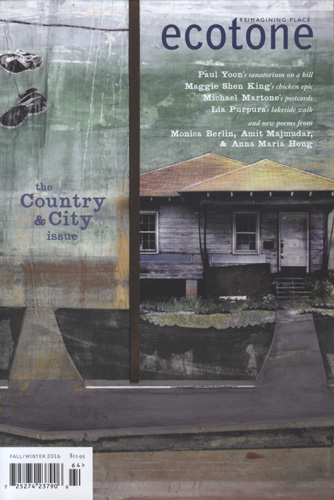Ecotone – Fall/Winter 2016
As a person who has left the hustle of city life to seek out the quieter world of a rural town myself, I loved every page of Ecotone’s Country and City Issue. Each piece highlights the beauty of country life or the flurried activity of city life, celebrating how we live in both worlds.
As a person who has left the hustle of city life to seek out the quieter world of a rural town myself, I loved every page of Ecotone’s Country and City Issue. Each piece highlights the beauty of country life or the flurried activity of city life, celebrating how we live in both worlds.
One of my favorite pieces in this issue is “A House of Her Own” by Maggie Shen King. This story details the struggle of a mother to find her place as her children are now grown and don’t really need her anymore. The next generation is seeking their own form of freedom, and she starts to realize that she has imposed, intentional or not, a weight on her family that she never intended to give them. Once she has finally come to realize this, she makes a big decision—to seek out “A haven where I am neither the paragon of familial virtue, its enforcer, nor its watchdog.” Throughout the story, the author provides such vivid details of city life, effortlessly introducing the reader to a rich culture even as she tells this bittersweet story of self-discovery.
Firmly rooted in country life is a story by Nathan Poole, titled “Open Season.” Here, Evangeline has discovered a new resident in a home on her family’s property who fixes up an old house that has been long abandoned:
All her life it was the “old house.” The place where the young man suddenly appeared one fall evening. Lit a fire. Made a home. [ . . . ] The familiar T-shaped, fable roofed farmhouse of the twenties and thirties, white-washed frieze boards and busted six-over-six paned windows along the rear sleeping board.
She finds herself spying on him, taking long walks every evening so she can see what he is doing. She daydreams of what the man might be like, letting her imagination run wild, letting it pull her away from the life she has made with her husband. However, as events unfold, she comes to find herself enjoying and even reveling in the life she has lived, setting aside her daydreams to be satisfied in her own life. I know how easy it is to get lost in a daydream, only to realize that the best things in life are the real things.
In “The Eel in the Raritan Canal” by Martha Silano, the poet spins a beautiful story of two lovers fishing in a canoe. “What did I know / about boats, about fishing, / about fish,” but she did know that “My love would help me / land it.” Through the poem, she spins the images of the fish’s trek, its journey, and its eventual demise in a way that reminds me of my own fishing trips on cold rivers in the mountains with my father when I was young, reveling in the quiet beauty of nature.
To demonstrate that not everything country is peaceful or quiet, the poem “The Buck” by Anthony Carelli starts with a trek through the woods that leads to an encounter with a buck: “A whitetail deer / a tremendous buck, / ten points, twelve maybe.” Unfortunately, this encounter takes a nasty turn when suddenly:
The snow belly flashed
as the buck reared up,
the four groins stretched
and the front hooves struck
painless quick punches.
While the creatures of the country may be majestic and beautiful, it is always important to remember just how dangerous they can be, as this unlucky traveler finds out. As my own father taught me, we should always respect nature, and give the wildlife a wide berth.
In another reminder of how beautiful, but tumultuous nature can be, David Gessner tells a story titled “The Death of the Shack.” In this nonfiction story, he describes building a writing shack and details events that occur around and to it over the years:
For almost five years my writing shack provided me with exactly what I was looking for. It quickly became my backshop. My fort. My hiding place. [ . . . ] An eye through which I could see herons, egrets, woodpeckers, ospreys, and every once in a great while, a quick glimpse of a clapper rail.
Even though the storms rage and cause havoc around the countryside, I could picture this shack on the edge of the forest by the river, its big window overlooking the water and spying on all the animals that frolicked there. Reading this story made me long for a cabin in the woods of my own—a quiet place to write, to think, to daydream, or to simply watch the birds.
Taking a very different turn is an interesting piece titled, “Kayla Sees the Low-Country” by Kayla E. Presented as a comic strip with images from around the low country of Georgia and South Carolina, each panel contains an image with a unique perspective of the city and country, accompanied by a small cartoon character and a quote from local publications dating back to 1861. This was certainly a unique glimpse of life in these states, of the buildings and the history there, each quote helping to paint a story that carries the reader from the mid-1800s to the mid-1900s.
Each piece in the “Country and City issue” of Ecotone paints a new perspective of life in either the country or the city, spanning different countries and different environments. Each one tells a new story through vivid imagery and gripping narratives, often accompanied by pictures to help illustrate the work, making me look forward to the next issue.
[www.ecotonemagazine.org]





